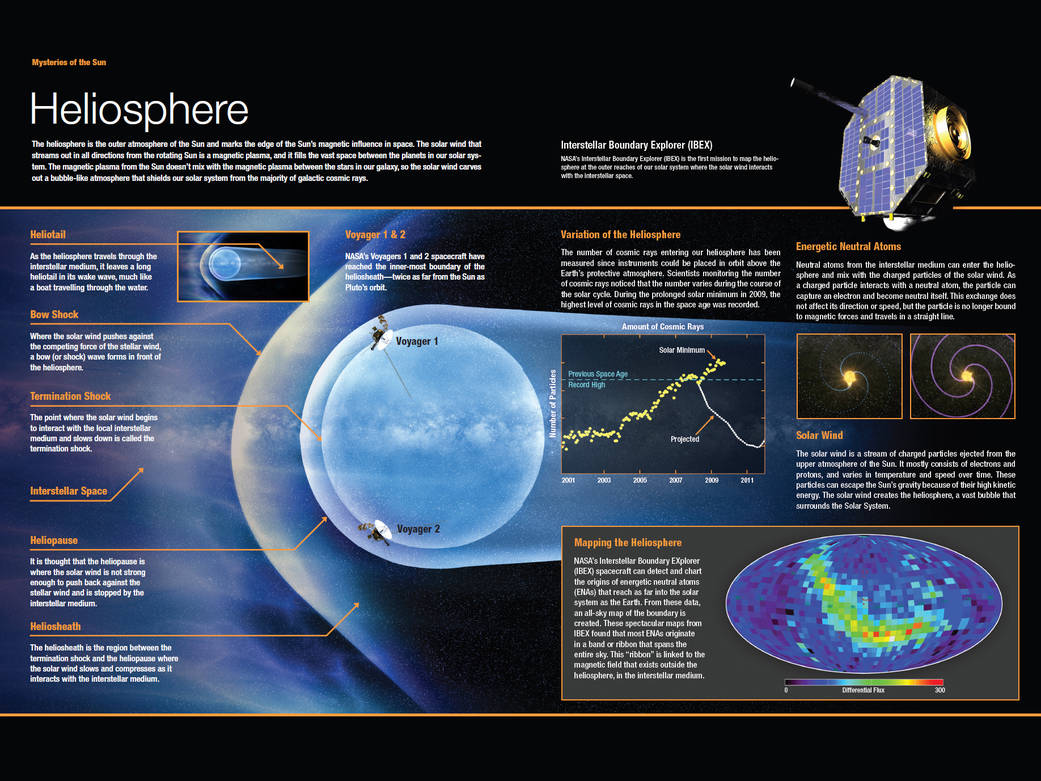The Heliosphere is the outer atmosphere of the Sun and marks the edge of the Sun’s magnetic influence in space. The solar wind that streams out in all directions from the rotating Sun is a magnetic plasma, and it fills the vast space between the planets in our solar system. The magnetic plasma from the Sun doesn’t mix with the magnetic plasma between the stars in our galaxy, so the solar wind carves out a bubble-like atmosphere that shields our solar system from the majority of galactic cosmic rays.Heliotail: As the heliosphere travels through the interstellar medium, it leaves a long heliotail in its wake wave, much like a boat travelling through the water.Bow Shock: Where the solar wind pushes against the competing force of the stellar wind, a bow (or shock) wave forms in front of the heliosphere.Termination Shock: The point where the solar wind begins to interact with the local interstellar medium and slows down is called the termination shock.Heliopause” It is thought that the heliopause is where the solar wind is not strong enough to push back against the stellar wind and is stopped by the interstellar medium.Heliosheath: The heliosheath is the region between the termination shock and the heliopause where the solar wind slows and compresses as it interacts with the interstellar medium.Voyager 1 & 2: NASA’s Voyagers 1 and 2 spacecraft have reached the inner-most boundary of the heliosheath-twice as far from the Sun as Pluto’s orbit.Interstellar Boundary Explorer (IBEX): NASA’s IBEX is the first mission to map the heliosphere at the outer reaches of our solar system where the solar wind interacts with the interstellar space.Variation of the Heliosphere: The number of cosmic rays entering our heliosphere has been measured since instruments could be placed in orbit above the Earth’s protective atmosphere. Scientists monitoring the number of cosmic rays noticed that the number varies during the course of the solar cycle. During the prolonged solar minimum in 2009, the highest level of cosmic rays in the space age was recorded.Energetic Neutral Atoms: Neutral atoms from the interstellar medium can enter the heliosphere and mix with the charged particles of the solar wind. As a charged particle interacts with a neutral atom, the particle can capture an electron and become neutral itself. This exchange does not affect its direction or speed, but the particle is no longer bound to magnetic forces and travels in a straight line.Solar Wind: The solar wind is a stream of charged particles ejected from the upper atmosphere of the Sun. It mostly consists of electrons and protons, and varies in temperature and speed over time. These particles can escape the Sun’s gravity because of their high kinetic energy. The solar wind creates the heliosphere, a vast bubble that surrounds the Solar System.Mapping the Heliosphere: NASA’s Interstellar Boundary EXplorer (IBEX) spacecraft can detect and chart the origins of energetic neutral atoms (ENAs) that reach as far into the solar system as the Earth. From these data, an all-sky map of the boundary is created. These spectacular maps from IBEX found that most ENAs originate in a band or ribbon that spans the entire sky. This “ribbon” is linked to the magnetic field that exists outside the heliosphere, in the interstellar medium.
Credit: NASA/Troy Bensech; Mapping the Heliosphere-NASA/IBEX
3 min read



























